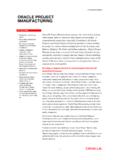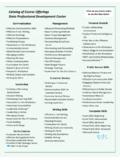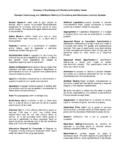Transcription of An Analysis of the Effects of Inventory Management on the ...
1 International Journal of Scientific and Research Publications, Volume 5, Issue 5, May 2015 1 ISSN 2250-3153 An Analysis of t he Effects of Inventory Management on the Performance of the Procurement Function of Sugar Manufacturing Companies in the Western Kenya Sugar Belt Cynthia Mito Mukopi1, Dr. Amuhaya Mike Iravo2 1 Master of Science in Procurement and Logistics, Jomo Kenyatta University of Agriculture and Technology 2 Supervisor, Jomo Kenyatta University of Agriculture and Technology Abstract- The research project examined the effect of Inventory Management on performance of the procurement function of sugar manufacturing companies in the western sugar belt. The first objective established the significance of a lean Inventory system on the performance of the procurement function of sugar manufacturing companies in the western sugar belt.
2 The second objective found out how strategic supplier partnerships in Inventory Management affect the performance of the procurement function of sugar manufacturing companies in the western sugar belt. The third objective investigated the effect of information technology in Inventory Management on the performance of the procurement function of sugar manufacturing companies in the western sugar belt. The fourth objective examined the effect of the legal policies on Inventory Management in the sugar industry on the performance of the procurement function of sugar manufacturing companies in the western sugar belt. Descriptive research design, specifically a survey study was employed in carrying out the research. The target population of the study consisted of a sample of procurement personnel of Mumias Sugar Company, West Kenya Sugar Company, Nzoia Sugar Company and Butali Sugar Mills which was 30 procurement personnel out of the total target population that was 100 procurement personnel.
3 The research instrument was structured questionnaires that were self administered to the respondents. Data was analyzed using SPSS and presented in tables and charts. The response rate was 87%. The ANOVA result for all variables indicated that there was a highly significant relationship between the variables at F = and P = This means that there is a strong relationship between the four variables; lean Inventory systems, strategic supplier partnerships, information technology, legal policies and the effect of Inventory Management on performance of the procurement function of sugar manufacturing companies in the western sugar belt. Index Terms- Inventory Management , Procurement Function, Performance I. INTRODUCTION nventory Management is a critical Management issue for manufacturing companies.
4 Inventories are vital to the successful functioning of manufacturing organizations. According to Buffa and Sarin (2007) there are several reasons for keeping Inventory . Too much stock could result in funds being tied down, increase in holding cost, deterioration of materials, obsolescence and theft. On the other hand, shortage of materials can lead to interruption of products for sales; poor customer relations and underutilized machines and equipments. Inventories may consist of raw materials, work-in-progress, spare parts/consumables, and finished goods. It is not necessary that a company has all these Inventory classes. But, whatever may be, the Inventory items, need Management as, generally, a substantial share of an Organization s funds is invested in them. Different departments within the same organization adopt different attitude towards Inventory .
5 For example, the sales department might desire large stock in reserve to meet virtually every demand that comes. The production department similarly would ask for stocks of materials so that the production system runs uninterrupted. On the other hand, the finance department would always argue for a minimum investment in stocks so that the funds could be used elsewhere for other better purposes, (Vohra, 2008:427). Inventory represents an important decision variable at all stages of product manufacturing, distribution and sales, in addition to being a major portion of total current assets of many organizations. The procurement function is responsible for managing the purchasing activity for the company (Lysons, 2012). There are two types of purchasing or procurement departments: centralized and decentralized.
6 In a centralized model, all requests for materials or goods are center to this department. In a decentralized model, individual departments can process their own purchases. Regardless of the organizational model used procurement is subject to more scrutiny and review than any other process. The use of company resources to purchase goods and services must be based on adherence to specific policies and procedures to reduce the chance of fraud and theft. The main purpose of the procurement function is to manage the process used for the purchase of goods and services by the organization. Inventory Management encompasses processes that ensure product availability while reducing investment costs (Krautter, 2009; Schroeder, 2000). For most companies, there are two forms of Inventory : Physical and Logical.
7 Physical Inventory includes all the materials that are tangible and required to fabricate the final product (Toomey, 2000). On the other hand, examples of logical Inventory are databases, Inventory tracking I International Journal of Scientific and Research Publications, Volume 5, Issue 5, May 2015 2 ISSN 2250-3153 software, et al. Proper synchronization of these two inventories is essential for proper Management of company assets. Inventory Management also involves identifying the most effective source of supply for each item in each stocking location. Forecasting and replenishment are also integral to Inventory Management . Koumanakos (2008) studied the effect of Inventory Management on firm performance 1, 358 manufacturing firms operating in three industrial sectors in Greece, food textiles and chemicals were used in the study covering 2000 2002 period.
8 The findings suggested that the higher the level of inventories preserved by a firm, the lower the rate of return. Agus and Noor (2006) did measure the perception of managers about the impact of Inventory Management practices on financial performance of manufacturing firms in Malaysia. However, circumstances in Malaysia could be different from those in Kenya. In the past, Inventory Management was not seen to be necessary. In fact excess inventories were considered as indication of wealth. Management by then considered over stocking beneficial. But today firms have started to embrace effective Inventory Management (Susan & Michael, 2000). Managers, now more than ever before, need reliable and effective Inventory control in order to reduce costs and remain competitive (Closs,1989).
9 According to Dobler and Burt (2006), Inventory alone account for as much as 30% of the organization invested capital. It s for this reason that the Government of Kenya through its Supplies manual (2007) instituted procedures and techniques for the purpose of effective Inventory Management . There are 3 sugar belts in Kenya, namely the Nyando, the Western sugar belt and the South Nyanza sugar zone. The western sugar belt occupies the western part of Kenya formerly the western province of Kenya in the counties of Kakamega, Bungoma and Busia. The sugar manufacturing companies in the Western Sugar belt are Mumias sugar company, West Kenya Sugar Company, Nzoia Sugar Company and Butali Sugar Mills. Mumias Sugar Company Limited is the largest sugar manufacturer in Kenya producing about 250, 000 metric tonnes (42%) of the estimated 600, 000 metric tonnes annual national output.
10 The company maintains is located in the town of Mumias, in Kakamega County, near the sugar plantations. West Kenya Sugar Company Limited is the fastest growing sugar company in Kenya located in Shamberere along the Kakamega Webuye road in Kakamega County. West Kenya, the second largest sugar producer in the country after Mumias, crushes 3,000 metric tonnes of raw cane daily. Nzoia Sugar Company Limited is one of the key players in Kenya s Sugar Industry. Nzoia Sugar Company is located in Bungoma County. The company serves over 67, 000 farmers in the larger Bungoma, Kakamega, Lugari and Malava Districts. Butali Sugar Company is an ultra modern sugar factory sugar factory within the heart of Kakamega County in the Western part of Kenya. The company is set in a rural peasant community.

















